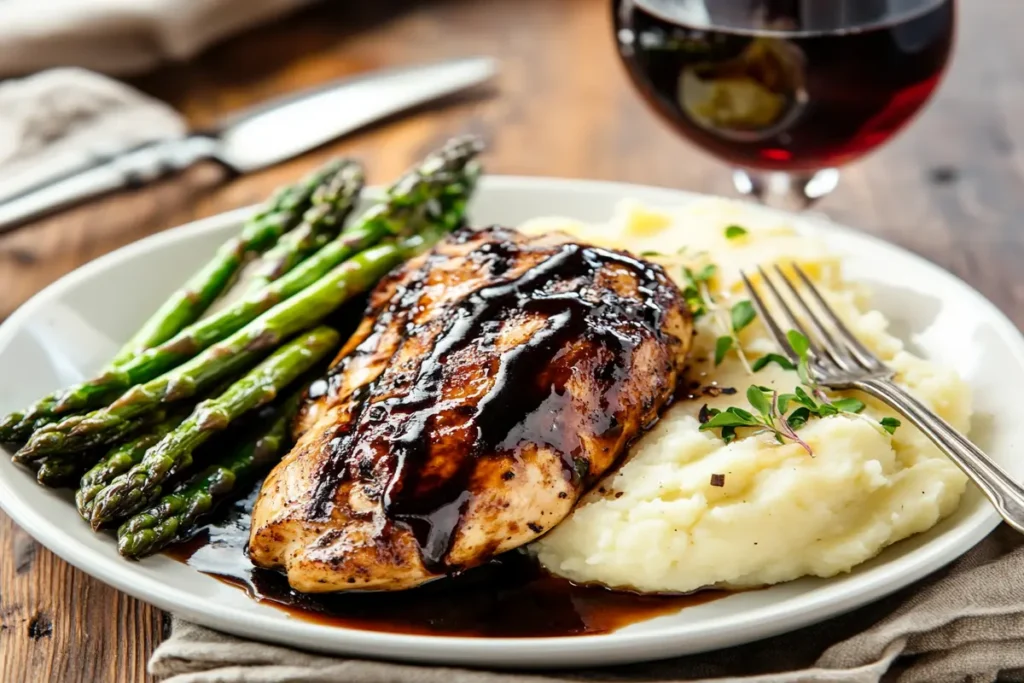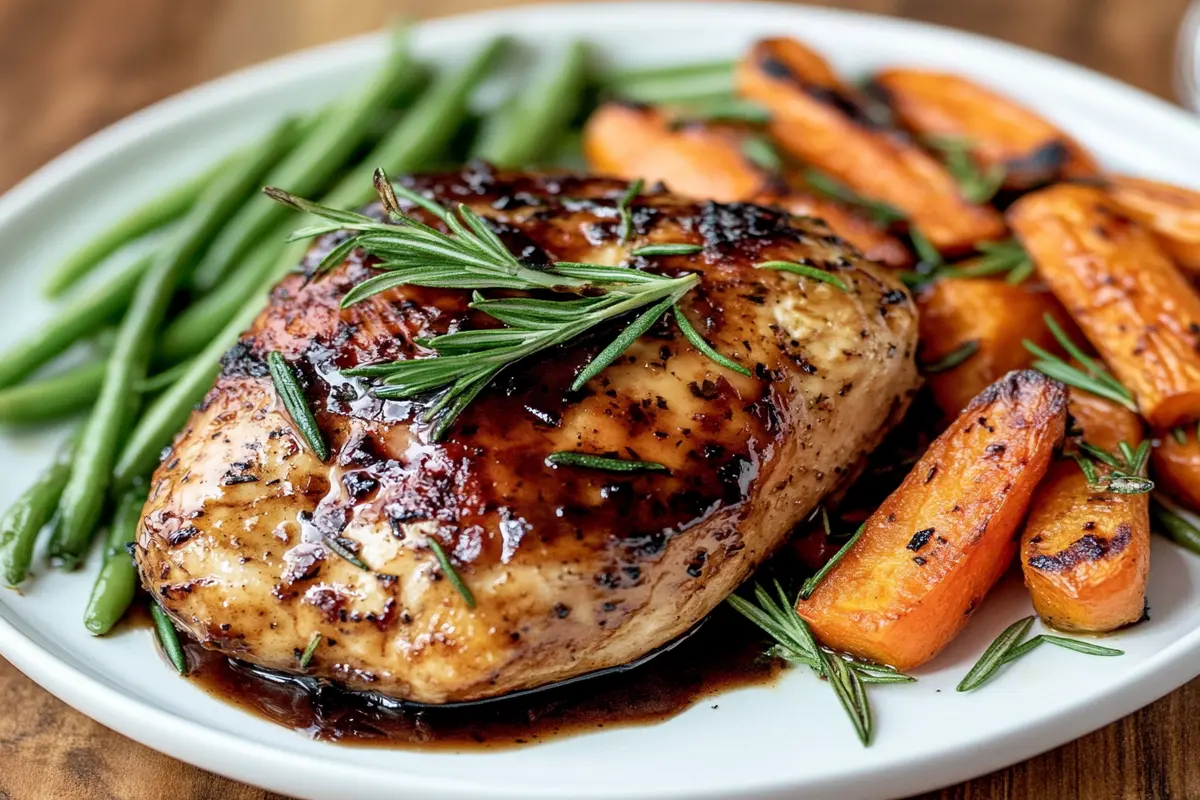Chicken and dressing is a timeless dish that embodies comfort and tradition. Often served during holidays and family gatherings, this hearty recipe combines tender chicken with flavorful, herb-filled dressing. With its versatility and rich history, chicken and dressing has earned a special place on tables across the country.
What is Chicken and Dressing Recipe?
Chicken and dressing is a baked dish that layers shredded chicken with a moist, savory bread-based dressing. Unlike stuffing, which is cooked inside a bird, dressing is baked in a separate dish, allowing for a golden, crispy crust and perfectly balanced flavors.
Origins of Chicken and Dressing Recipe?
This dish has roots in Southern cooking, where cornbread is a staple ingredient. Influenced by English stuffing recipes, Southern cooks adapted the dish to include locally available ingredients like cornbread, fresh herbs, and rich chicken broth. Over time, chicken and dressing became a go-to meal for celebratory occasions like Thanksgiving and Christmas.
Why It’s a Holiday and Family Gathering Favorite
Chicken and dressing is not only delicious but also practical. Its large portion size makes it perfect for feeding a crowd, and it pairs beautifully with traditional sides like cranberry sauce and gravy. The combination of savory herbs and tender chicken evokes a sense of nostalgia, making it a must-have dish for festive gatherings.
Key Ingredients for Chicken and Dressing Recipe?

Crafting the perfect chicken and dressing requires the right balance of high-quality ingredients. Here’s what you’ll need:
Choosing the Right Chicken: Whole, Breast, or Thighs
- Whole Chicken: Ideal for a rich, flavorful broth, as it includes both white and dark meat.
- Chicken Breasts: Lean and tender, perfect if you prefer lighter meat.
- Chicken Thighs: Juicier and more forgiving during cooking, great for bold flavor.
Using pre-cooked rotisserie chicken can save time while still delivering delicious results.
Bread Choices for Dressing: Cornbread vs. White Bread
- Cornbread: The traditional choice, offering a slightly sweet, crumbly texture that soaks up flavors beautifully.
- White Bread: Adds softness to the dressing and balances the richness of cornbread.
- Combination: Many recipes use a mix of both for the best texture and taste.
Essential Herbs and Seasonings for Flavor
- Sage and Thyme: Classic herbs that provide earthy, savory notes.
- Onion and Garlic: Essential aromatics that build depth in the dish.
- Black Pepper and Salt: Balance the overall flavor profile without overpowering the other ingredients.
Broth and Dairy: Building Moisture and Texture
- Chicken Broth: Adds moisture and enhances the savory flavors.
- Butter: Ensures the dressing is rich and indulgent.
- Dairy (Milk or Cream): Adds a creamy element, making the dressing extra tender.
Tools and Equipment You’ll Need
Having the right tools ensures a smooth cooking process and consistent results.
Baking Dish, Skillet, and Mixing Bowls
- Baking Dish: A 9×13-inch dish is perfect for even cooking and a golden crust.
- Skillet: Useful for sautéing aromatics like onions, celery, and garlic.
- Mixing Bowls: Essential for combining ingredients thoroughly.
Thermometer for Perfectly Cooked Chicken
Using a meat thermometer ensures the chicken is cooked to a safe internal temperature of 165°F. This tool is especially helpful when cooking whole chickens or larger cuts of meat.
Preparing and Cooking Chicken and Dressing
Chicken and dressing is a comforting, flavorful dish that requires attention to detail in both preparation and cooking. By following these steps, you’ll ensure a perfect balance of moist, savory dressing and tender, juicy chicken. Whether you’re preparing it for a holiday feast or a casual family dinner, mastering the basics will make this recipe a success.
Step-by-Step Preparation
Cooking and Shredding the Chicken

Cooking the chicken properly is the foundation of this recipe. Whether you choose to bake, boil, or use a rotisserie chicken, starting with well-cooked, seasoned chicken ensures a flavorful result.
- Boiling Method:
- Place a whole chicken, breasts, or thighs in a large pot.
- Add aromatics like onion, celery, and garlic, along with herbs such as thyme and bay leaves.
- Cover the chicken with water or broth, bring to a boil, and then reduce the heat to a simmer.
- Cook for 20–30 minutes for breasts or thighs, or 60 minutes for a whole chicken, until the internal temperature reaches 165°F.
- Shred the Chicken:
- Once cooked, let the chicken cool slightly for easier handling.
- Use two forks or your hands to shred the meat into bite-sized pieces. Set it aside for layering later.
Pro Tip: Save the cooking liquid to use as a flavorful broth in the dressing mixture.
By cooking the chicken carefully and using the broth, you’ll add a deeper layer of flavor to the dish, ensuring every bite is moist and savory.
Preparing the Cornbread or Bread Base
The bread base is what gives dressing its texture and character. While cornbread is traditional, adding white bread or biscuits can create a more balanced flavor.
- Cornbread Preparation:
- Bake cornbread a day ahead using your favorite recipe or a boxed mix.
- Crumble the cornbread into a large mixing bowl, ensuring the pieces are small and evenly sized.
- White Bread Addition:
- Tear or cut slices of day-old white bread into small cubes.
- Mix with the crumbled cornbread for a combination that is moist yet holds its shape.
- Optional Additions:
- Include toasted breadcrumbs or crushed crackers for extra texture and depth.
Pro Tip: Using day-old bread prevents the dressing from becoming too mushy, as it absorbs liquid more effectively.
By combining cornbread and white bread, you’ll achieve a texture that is both hearty and cohesive, making the dressing the perfect complement to the chicken.
Combining Ingredients for the Dressing Mixture
Once your bread base and chicken are ready, it’s time to combine everything into a flavorful, cohesive mixture.
- Sauté Aromatics:
- Heat butter in a skillet and sauté diced onions, celery, and garlic until softened and fragrant.
- Sprinkle in sage, thyme, and a pinch of black pepper for added aroma.
- Mix the Ingredients:
- In a large mixing bowl, combine the crumbled bread, shredded chicken, sautéed aromatics, and any optional additions like mushrooms or cooked sausage.
- Slowly pour in chicken broth and stir until the mixture is moist but not soggy.
- Adjust Consistency:
- Add a splash of milk or cream if the mixture feels too dry.
- If it’s too wet, incorporate a bit more crumbled bread to absorb excess liquid.
Pro Tip: Taste the mixture before baking and adjust seasoning as needed. This ensures the dressing is perfectly balanced before it hits the oven.
By layering flavors and adjusting the texture carefully, you’ll create a dressing mixture that is rich, moist, and well-seasoned.
Cooking Techniques for Chicken and Dressing Recipe?
Layering Chicken and Dressing for Even Cooking
Layering ensures that the chicken and dressing bake evenly, creating a cohesive dish with every bite.
- Prepare the Baking Dish:
- Grease a 9×13-inch baking dish with butter or nonstick spray.
- Spread a thin layer of dressing mixture on the bottom to create a base.
- Layer the Chicken:
- Add a generous layer of shredded chicken on top of the dressing.
- Spread the remaining dressing mixture over the chicken, pressing it down gently for even coverage.
Pro Tip: Distributing the layers evenly prevents the dish from drying out and ensures every slice has a balanced mix of chicken and dressing.
Baking to Achieve a Golden Crust
The hallmark of great chicken and dressing is a golden, slightly crisp crust on top. Achieving this requires proper baking techniques.
- Bake at the Right Temperature:
- Preheat your oven to 375°F (190°C) and cover the dish loosely with foil to retain moisture.
- Bake for 30 minutes, then remove the foil to allow the top to crisp.
- Check for Doneness:
- Bake for an additional 15–20 minutes, or until the top is golden brown and the dressing is set.
Pro Tip: A quick brush of melted butter on top before baking enhances the crust’s flavor and appearance.
Adjusting Baking Time Based on Dish Size
The size and depth of your baking dish can impact cooking time.
- Smaller Dishes: Reduce baking time by 5–10 minutes to prevent overcooking.
- Deeper Dishes: Add an extra 10 minutes to ensure the center is cooked through.
Checking the center with a knife or toothpick ensures the dressing is fully cooked without being dry or mushy.
Broth and Seasoning Adjustments
Tips for Achieving the Right Consistency
Consistency is key to a successful dressing. If the mixture feels too wet, it may become soggy during baking. On the other hand, a dry mixture will lack the desired creaminess.
- Add broth gradually, stirring between additions to monitor moisture levels.
- If the dressing seems too dry after baking, drizzle a small amount of warm broth over the top before serving.
Balancing Flavors with Sage, Thyme, and Onion
Herbs and aromatics are essential for creating a dressing that is flavorful but not overwhelming. Adjusting the amount of sage and thyme can help strike the right balance:
- For a more pronounced herb flavor, add extra sage and thyme, but be cautious not to overpower the other ingredients.
- Onion and garlic bring depth to the dish but should be finely chopped to ensure they blend seamlessly.
Pro Tip: A touch of paprika or cayenne can add subtle warmth and enhance the dish’s complexity.
Serving, Variations, and Leftovers for Chicken and Dressing Recipe?
Chicken and dressing is more than just a holiday staple; it’s a dish that shines in both its presentation and versatility. Whether served with traditional sides, creatively adapted for different flavors, or saved for later enjoyment, this meal remains a favorite for all occasions. Let’s explore how to serve it, customize it, and store it for future meals.
Serving Suggestions for Chicken and Dressing Recipe?
Presentation plays a crucial role in making chicken and dressing appealing for both casual dinners and special occasions. Paired with the right sides and garnishes, this dish becomes the star of the table.
Traditional Sides: Gravy, Cranberry Sauce, and Greens
Chicken and dressing is often served with classic sides that enhance its rich flavors. These pairings not only add variety but also balance the meal:
- Gravy:
- A warm, savory gravy poured over the dressing adds moisture and depth. Traditional chicken or turkey gravy works best, as its flavors complement the herbs in the dressing.
- Cranberry Sauce:
- The tangy sweetness of cranberry sauce provides a refreshing contrast to the savory elements of the dish. Whether you prefer canned or homemade, this side adds a vibrant touch to the plate.
- Greens:
- Southern-style collard greens or sautéed spinach are excellent accompaniments. Their earthy flavors pair well with the dressing’s herbaceous notes while adding a nutritious element.
Pro Tip: Include a bread basket with dinner rolls or cornbread muffins to round out the meal and provide additional options for soaking up gravy.
Plating Ideas for Holidays and Casual Dinners
Plating chicken and dressing with care elevates its appeal and makes the meal feel more special:
- For Holidays:
- Serve the dressing in a decorative casserole dish with a sprinkle of fresh parsley or sage on top for a festive look.
- Arrange sliced cranberry sauce or garnished gravy boats on the side for added elegance.
- For Casual Dinners:
- Plate individual portions of dressing and chicken with a small bowl of gravy and a side of steamed vegetables.
- Use warm, earthy-toned plates to highlight the dish’s cozy, comforting feel.
Adding visual elements like garnishes or brightly colored sides enhances the overall dining experience, making the dish as delightful to look at as it is to eat.
Recipe Variations
One of the joys of chicken and dressing is its adaptability. With a few tweaks, you can customize the dish to suit different tastes, dietary needs, or seasonal ingredients.
Adding Sausage or Bacon for Extra Flavor
For a heartier twist, incorporate cooked sausage or bacon into the dressing mixture:
- Sausage:
- Brown ground sausage and mix it into the bread base before baking. The savory flavor of sausage pairs wonderfully with sage and thyme.
- Bacon:
- Crumble crispy, cooked bacon and sprinkle it throughout the dressing for a smoky, salty kick.
Adding these proteins not only enriches the flavor but also makes the dish feel more robust and satisfying.
Incorporating Vegetables: Celery, Carrots, and Mushrooms
Vegetables can add texture, color, and nutritional value to your chicken and dressing:
- Celery and Carrots:
- These classic aromatics can be sautéed with onions and garlic before being mixed into the dressing. They provide a slight crunch and subtle sweetness.
- Mushrooms:
- Sautéed mushrooms add a rich, umami flavor that complements the chicken and herbs. They work particularly well in vegetarian adaptations.
By including vegetables, you create a dish that is not only more colorful but also well-rounded in flavor and nutrition.
Gluten-Free and Low-Carb Adaptations
For those with dietary restrictions, chicken and dressing can be adapted without losing its comforting appeal:
- Gluten-Free:
- Use gluten-free cornbread and bread alternatives to create a dressing that accommodates gluten sensitivities.
- Low-Carb:
- Replace the bread base with riced cauliflower or a mixture of almond flour and cheese for a keto-friendly version.
These substitutions ensure everyone can enjoy the dish, regardless of their dietary needs.
Storing and Reheating Leftovers
Chicken and dressing makes excellent leftovers, but proper storage and reheating techniques are essential to maintain its flavor and texture.
Refrigeration Tips to Maintain Moisture
To keep leftovers fresh:
- Cool Before Storing:
- Allow the dish to cool to room temperature before transferring it to airtight containers. This prevents condensation, which can make the dressing soggy.
- Store Properly:
- Place the chicken and dressing in separate containers if possible. This allows for easier reheating and prevents the dressing from absorbing too much moisture.
Leftovers can be stored in the refrigerator for up to 3 days.
Reheating Methods: Oven, Microwave, or Skillet
Reheating chicken and dressing correctly ensures it remains moist and flavorful:
- Oven:
- Preheat the oven to 350°F (175°C). Place the dressing in an oven-safe dish, cover with foil, and bake for 15–20 minutes. Add a splash of broth if needed to restore moisture.
- Microwave:
- Transfer a single portion to a microwave-safe dish and heat in 30-second intervals, stirring between each to ensure even reheating.
- Skillet:
- For small portions, reheat on the stovetop over low heat, adding a bit of broth or butter to prevent drying out.
Each method works well, but the oven is best for maintaining the original texture of the dish.
Freezing Chicken and Dressing Recipe for Future Meals
Chicken and dressing can be frozen for longer storage, making it a convenient option for meal prep:
- Freezing:
- Divide the dish into portions and store in freezer-safe containers. Wrap tightly to prevent freezer burn.
- Thawing:
- Defrost in the refrigerator overnight before reheating using your preferred method.
Frozen chicken and dressing can be stored for up to 3 months, making it an excellent choice for quick, comforting meals later on.
FAQs About Chicken and Dressing Recipe?
1. What is the difference between stuffing and dressing?
Stuffing is traditionally cooked inside the cavity of a bird, like turkey or chicken, while dressing is prepared and baked in a separate dish. Dressing tends to have a crispier top and more even texture.
2. Can I make chicken and dressing ahead of time?
Yes! You can prepare the dressing mixture and shred the chicken up to a day in advance. Store them separately in airtight containers in the refrigerator, and assemble and bake the dish when ready to serve.
3. What is the best way to keep dressing moist?
Adding enough chicken broth during preparation is key. Covering the dish with foil while baking also helps retain moisture, especially during the initial cooking phase.
4. Can I use store-bought rotisserie chicken for this recipe?
Absolutely! Rotisserie chicken saves time and still provides tender, flavorful meat for the dish.
5. How do I know when my dressing is fully cooked?
The dressing is done when the top is golden brown, and the center feels set and not wet when you insert a knife or toothpick. The internal temperature should reach 165°F.
6. Can I freeze leftover chicken and dressing?
Yes, chicken and dressing freezes well. Store it in an airtight container or freezer-safe bag for up to 3 months. Thaw in the refrigerator before reheating.
7. Can I make chicken and dressing gluten-free?
Yes! Substitute traditional bread with gluten-free cornbread and gluten-free bread cubes. Ensure your broth and seasonings are gluten-free as well.
8. What can I substitute for cornbread if I don’t have any?
You can use day-old white bread, biscuits, or a mix of both. For a slightly different flavor, try using sourdough bread.
9. What vegetables can I add to the dressing?
Popular choices include sautéed celery, onions, carrots, and mushrooms. These vegetables add flavor and texture to the dish.
10. What are the best herbs for seasoning dressing?
Sage and thyme are classic choices, but rosemary, parsley, and a touch of paprika can also enhance the flavor. Adjust the seasoning to suit your personal taste.

